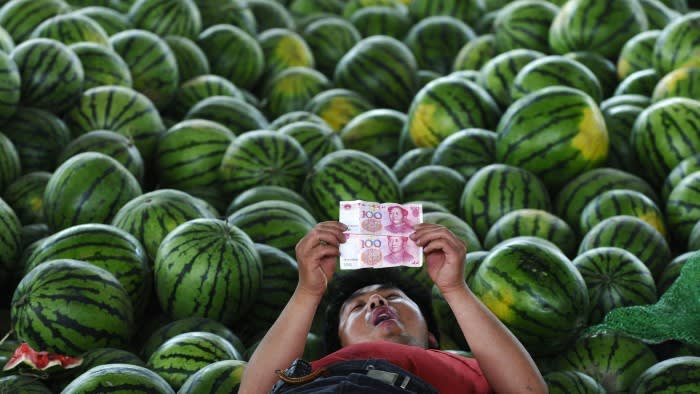Stay informed with free updates
Simply sign up to the Foreign exchange myFT Digest — delivered directly to your inbox.
Foreign investors including hedge funds, banks and wealthy families have piled into a $130bn carry trade that takes the other side of China’s attempt to support its currency.
It works like this. First, foreign investors lend US dollars to Chinese counterparties via currency swaps, receiving the equivalent in renminbi. They can usually earn a positive carry from the difference between the current exchange rate and the one year forward exchange rate, when the swap is unwound.
Then they use the RMB to buy interbank negotiable certificates of deposit – a type of short-dated government note. The combined yield from loaning the dollars and investing in bonds in a one year tenor can be up to 6 per cent, easily beating the sub-4 per cent yield available on a US treasury bond.

We outlined the strategy for MainFT last month and spoke to some of the investors who love it:
“When you do a forward to hedge your exposure, it is quite an attractive yield pick-up,” at currently about 4 percentage points on an annualised basis, on top of underlying government bond yields, said Sabrina Jacobs, a portfolio manager at Pictet Asset Management. “That gets you in the 6 per cent region, in US dollars, for an asset class that is very uncorrelated to the US market.”
There’s a balancing act in this trade. When potential monetary easing in China drives down local interest rates, Chinese investors become hungrier for dollars, which pushes swap rates higher, and raises the return of the combined strategy. There has long been a similar trade and a pick up for dollar investors on yen swaps.
The popular trade pairs have generated an estimated $131.76bn inflows from November to July, according to BNP Paribas Securities, one of the biggest offshore brokers of China bonds.
A note from Citic Futures on the trade shows the impact this is having on foreign ownership of certificates of deposit (CDs):

For now, the yield-farming strategies are tolerated by China’s central bank.
Chinese state banks, the counterparties, rely on the currency swaps to build short positions in the dollar offshore and stabilise the yuan’s exchange rate — a key political agenda under president Xi Jinping. They’re usually seen as proxies of China’s monetary authority.
“At its core, it’s a currency trade,” said Wang Qi, chief investment officer for wealth management at UOB Kay Hian in Hong Kong. “It has nothing to do with the attraction of China [government bonds]. Traders make an arbitrage out of dollar shortage among Chinese institutions, who demand more dollars.”
Wang added: “I suspect too many Chinese institutions are doing the opposite, exchanging renminbi to US dollar now. This changes the dynamics of the swap market, giving the other side an advantage.”
So how could the carry trade unwind? One ever-present risk when trading China, as demonstrated today, is policy.
Jason Pang, Asia FX & Rates Portfolio Manager at JP Morgan Asset Management, said that a jump-start to the Chinese economy would be bad for the trade. “If there were a big stimulus or big risk-on that causes CGBs to sell off that could become a pain trade, so it’s a policy risk.”
But he added: “CGBs have very different beta/low correlation to US treasuries, they’re priced heavily for rate cuts. CGBs become a very interesting left-tail hedge, so it ticks a lot of boxes. It will remain a cornerstone trade for the rest of year.”
Big swings from FX swaps — the core driver of the strategy — create another risk.
If the RMB rapidly appreciates against the dollar, for example following jumbo rate cuts from the Federal Reserve, the trade’s juice will soon diminish as demand for US dollars eases.
“People still like this trade idea,” Wang said. “But given the spreads have compressed, investors are patient right now. They’re waiting for either a correction in bonds, or a correction in foreign exchange swaps to consider the timing to come back in.”
The arbitrage spread for foreign investors on the strategy has narrowed by 0.29 per cent from July to mid August, according to Citic’s note, and moderated further as the yuan strengthened lately.
Still, compared to US treasuries, the trade remains attractive and it stands. Dollar performed strongly even after Fed’s interest rate cut on Thursday.
“If the trade unwinds, it could put pressure on short-term government bond yields,” said BNP’s Wang Ju. “The PBoC might respond with a reserve requirement ratio cut or open market operations to offset the outflows. With a stronger yuan, the constraints on monetary policy should ease, giving the PBoC room to adjust policy.”
https://www.ft.com/content/cf0fc67d-e51f-46ba-b495-0c4675e0d151


